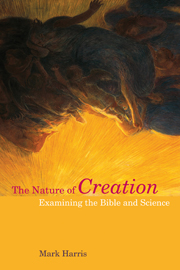Book contents
- Frontmatter
- Contents
- Preface
- Abbreviations
- 1 Introduction
- 2 Creation According to Modern Science
- 3 Creation According to the Bible I: Genesis
- 4 Creation According to the Bible II: The Creation Motif
- 5 The Framework of Biblical Cration
- 6 Creator–creation: How can a Ralationship be Described?
- 7 The Fall
- 8 Suffering and Evil
- 9 Scientific Eschatology and New Creation
- 10 Conclusions
- Bibliography
- Index of Ancient Citations
- Index
3 - Creation According to the Bible I: Genesis
- Frontmatter
- Contents
- Preface
- Abbreviations
- 1 Introduction
- 2 Creation According to Modern Science
- 3 Creation According to the Bible I: Genesis
- 4 Creation According to the Bible II: The Creation Motif
- 5 The Framework of Biblical Cration
- 6 Creator–creation: How can a Ralationship be Described?
- 7 The Fall
- 8 Suffering and Evil
- 9 Scientific Eschatology and New Creation
- 10 Conclusions
- Bibliography
- Index of Ancient Citations
- Index
Summary
THE FIRST GENESIS CREATION ACCOUNT: GENESIS 1:1–2:4a (p)
The “Priestly” author
The recognition that there are two distinct accounts of creation in the early chapters of Genesis is one of the foundation stones of the “documentary hypothesis” (Chapter 1). Although there have been many criticisms and revisions since Wellhausen's definitive formulation, the basic idea has stuck fast in biblical scholarship. Therefore, we will continue to use the terminology of the “Yahwist” and “Priestly” authors when looking at these first few crucial chapters of Genesis, without taking too firm a commitment on historical formulations behind them. Indeed, for the sake of convenience we will refer to the Genesis 1–2 creation story as P, and the Genesis 2–3 story as J. This is not meant to imply a firm commitment to any particular version of the documentary hypothesis so much as the general recognition that we are dealing here with at least two distinct creation traditions. But equally, it is worth bearing in mind that, from the point of view of the biblical canon which has been passed down to us, these creation stories are told together. And indeed, the relationship between them may be even more intimate. It is quite possible, for instance, that one (probably P) was composed at least in part as an introduction and complement to the other (Fretheim 2005: 33).
- Type
- Chapter
- Information
- The Nature of CreationExamining the Bible and Science, pp. 35 - 58Publisher: Acumen PublishingPrint publication year: 2013



